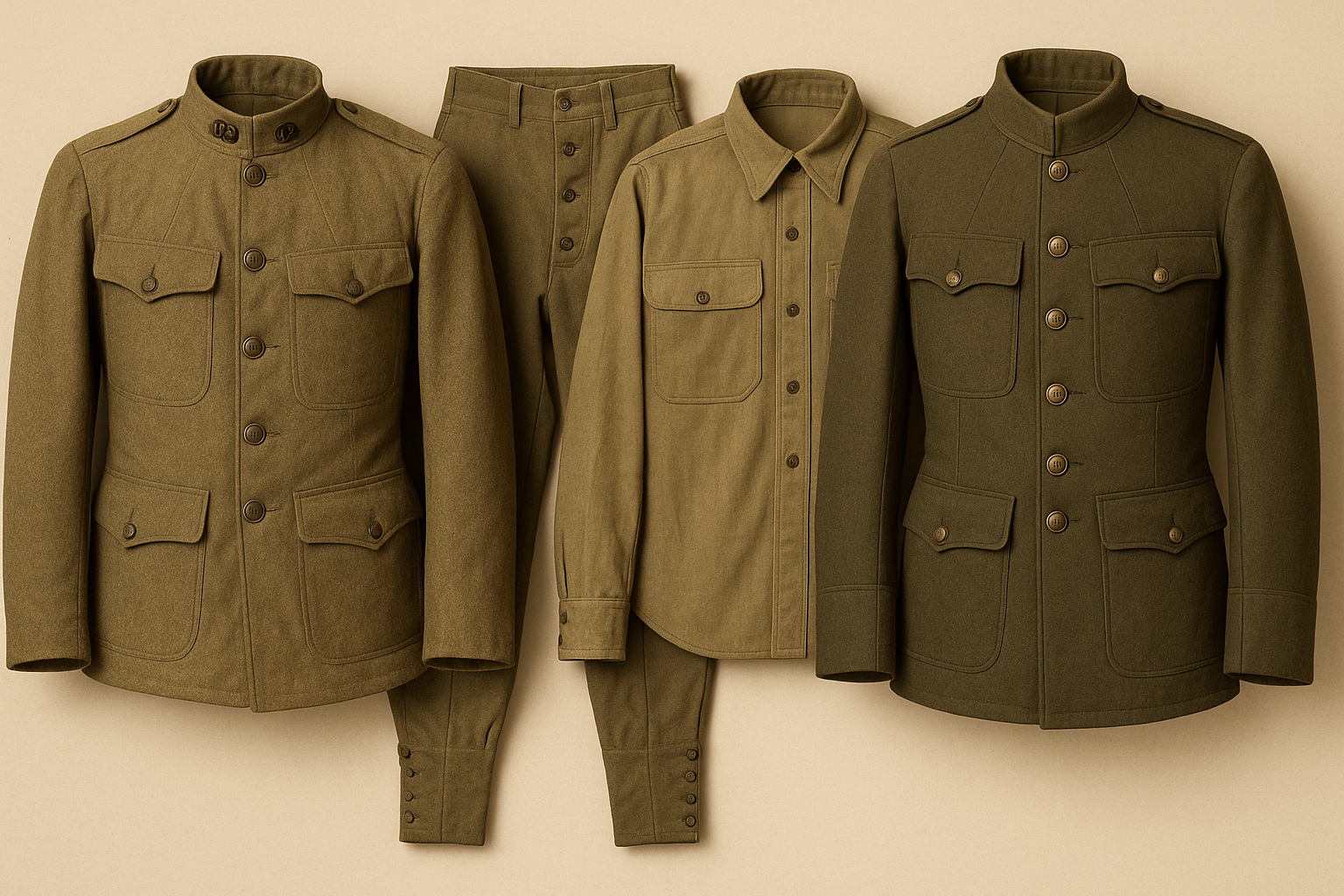
WWI US Army Uniform Parts: Exploring the Iconic Gear of the Great War
Published on Jun 30, 2025
WWI US Army Uniform Parts: A Complete Breakdown of Soldier Gear.
World War I changed the course of history and revolutionized military gear. The WWI US Army uniform was not only a product of function but also of evolving warfare demands. Designed for trench warfare, long marches, and harsh conditions, every piece had a specific role, from the World War One jacket to the WW1 pants.
In this guide, we’ll discuss the most crucial parts of the US Army uniform during World War I and how these historic items evolved over time. Whether you're a reenactor, military enthusiast, or collector, understanding these pieces adds a layer of authenticity to your interest—and at Paddelaters.com, you’ll find high-quality reproductions to complete your look.
1. The World War One Jacket: The Backbone of the Uniform
The World War One jacket, also known as the M1917 or M1912 wool service coat, was the centerpiece of the American soldier’s attire. Made from thick wool and tailored to balance formality with battlefield practicality, it was both a defense against the elements and a symbol of the soldier’s identity.
Key Features of WWI Jackets:
- Olive drab color for camouflage
- High collar with brass US insignia
- Four large front pockets
- Reinforced stitching for durability
- Wool lining for insulation
Today’s reproductions at Paddelaters pay attention to every detail, offering options for collectors and reenactors who seek authenticity down to the stitching.
2. WW1 Pants: Rugged and Ready for Battle
When you think of WW1 pants, envision high-waisted, wool trousers designed to endure mud, cold, and long patrols. Known as the “breeches,” these trousers were tight at the calves and loose at the thighs, allowing flexibility while ensuring they could be tucked into tall leather boots.
Why They Were Unique:
- Made of durable wool for warmth and endurance
- Lace-up or buttoned calves to prevent snagging
- Often paired with puttees (leg wraps) for added support
Modern military pants are vastly different, but WW1 pants set the foundation for what rugged military lower wear should be. You can explore accurate reproductions on our site under the WW1 Pants section.
3. Army Green Fatigues: Evolution from the Trenches
Although OD (Olive Drab) Green Fatigues became more prominent in WWII and beyond, the roots of this military staple can be traced back to the field gear issued during WWI. While not as formal as the woolen dress jacket, early OD fatigues were essential for behind-the-lines work and camp duty.
Usage of Army Green Fatigues:
- Worn during training and non-combat duties
- Designed for comfort and ease of movement
- Evolved into standardized fatigues by WWII
While WWI didn’t fully embrace OD fatigues as we know them today, reenactors often pair them with WWI gear to reflect transitional phases of military fashion. Our Army Green Fatigues collection represents this blend of history and practicality.
4. Army Dress Jacket: Pride in Uniform
The Army Dress Jacket of WWI had to look sharp for ceremonial purposes and official functions while still reflecting military discipline. It resembled the field jacket but was more tailored, with fewer external features and often cleaner lines.
Characteristics of the Dress Jacket:
- Slim fit with tailored shoulders
- Brass buttons and officer insignia
- Typically worn with breeches and polished boots
Collectors and museum-quality enthusiasts often seek accurate army dress jackets for display or reenactment. Paddelaters offers historically accurate versions that replicate the look and feel of the originals down to the fabric choice.
5. WW2 German Leather Jacket: A Niche but Growing Interest
Though not a WWI piece, many collectors interested in military history also explore WWII gear, particularly the WW2 German leather jacket. Known for its sharp design and rugged feel, it’s a favorite among historical fashion collectors and reenactors.
This jacket doesn't belong to the WWI US uniform, but many vintage military fans appreciate its craftsmanship and historical significance. If your interest spans broader wars, don’t miss our selection of WW2 German leather jackets.
6. Footwear and Accessories: Completing the Look
To wear a WWI uniform authentically, one must go beyond jackets and pants. Accessories mattered:
Essential Gear Included:
- Puttees: Wrapped cloth for ankle support
- Brogans or trench boots: Durable leather shoes
- M1910 web belt: For carrying canteens and ammo
- Gas mask bag and steel helmet: For protection
All these elements add to the uniform's realism and function—and they're vital components for reenactments or museum displays.
How to Buy Authentic WWI Uniform Parts Online
When shopping for WWI uniforms, authenticity and material quality are key. At Paddelaters.com, we specialize in accurate reproductions of historical military attire, including:
- WW1 field jackets and dress uniforms
- Wool breeches and army trousers
- Fatigue sets and accessories
- WW2 and interwar period outerwear
Our pieces use period-correct fabrics and patterns to ensure you get as close as possible to the real thing.
Final Thoughts: Why WWI Uniforms Still Matter
Over a century later, WWI US uniforms captivate military historians, fashion collectors, and reenactors. These garments were more than just clothing—they were part of a soldier’s identity, forged in mud, fire, and sacrifice.
Each item tells a story, from the structured World War One jacket to the essential WW1 pants and the symbolic army dress jacket. Whether you’re honoring a relative’s legacy, building a collection, or participating in living history, there’s no better place to begin than at Paddelaters.com.
